Video produced by Andrea Carcovich
They say everything is bigger in Texas, and in Dallas, the state’s largest metropolitan area, that maxim couldn’t be truer. From food to music to business, there aren’t many cities that rival Dallas’ special place in American culture.
There’s more to “Big D” than just its quintessential BBQ-brisket-and-football persona, however.
The city, home to 1.3 million people, has a deep heritage rooted in everything from international commerce, transportation, manufacturing and agriculture to go along with its fondness for the arts, including the opera, ballet, musicals and symphony concerts.
Dallas is also rich with dynamic architecture. Boasting a terrific skyline of office skyscrapers that house many of the world’s most successful companies, Dallas, along with adjacent Fort-Worth and the vast suburbs that dot the area, features an impressive mix of modern and classic structures that make the city a destination for any architecture enthusiast.
Here are the five buildings that best epitomize Dallas architecture.
Perot Museum of Nature and Science
- Opened in 2012; designed by Thom Mayne at Morphosis Architects
- Initially designed as a large cube floating over a landscaped base
- Has a stone roof featuring landscaped drought-tolerant greenery from local surroundings
- By integrating nature and technology into the building’s design, the building can also serve as a teaching tool for scientific purposes
- Features sustainable systems like rainwater collection from the roof and parking lot, satisfying 100% of the building’s irrigation needs
Margaret Hunt Hill Bridge
- The bridge spans the Trinity River and is named for the heiress and philanthropist
- Designed by Santiago Calatrava; opened in 2012
- Costing nearly $200 million, the bridge has a signature 40-story center-support arch that can be seen from miles away; this has become one of Dallas’ skyline-defining features
- Includes a cable-stayed structure design that reminds some of a large musical instrument, similar to Calatrava-designed bridges in Italy
- Six lanes of the bridge’s vehicular traffic span 1,870 feet
Dallas City Hall
- Designed by famed architect I.M. Pei; opened in 1978
- Designed partly in an effort to rebuild the city’s image following the JFK assassination
- Striking inverted pyramid design serves government space requirements—public areas needed less space at the bottom than the top-floor offices
- The building’s foundation and basement levels are much wider than the apparent footprint structure, expanding out for structural stability
- Buff-colored concrete designed to resemble Texas earth tones
Reunion Tower
- The building, a 561-foot observation tower, is one of Dallas’ most-recognizable landmarks
- Built in 1978 by Welton Becket & Associates, the tower is also known as “The Ball”
- The tower was conceived as part of a redevelopment project; it also used to house radio stations
- The top three floors are encased in an open-air sphere, resulting in a geodesic dome formed with aluminum struts
- The tower’s 68-second elevator ride to the top provides views of the city through glass panels running the entire length of the elevator shaft
- The structure has a state-of-the-art LED lighting system at the top with “pixels” 16 inches in diameter that can display animations and graphics, which is used to mark holidays and special events
Cathedral Santuario de Guadalupe
- Serves as the cathedral church of the Roman Catholic Diocese of Dallas
- Constructed in the late 19th century; finished in 1902 by Nicholas J. Clayton
- Designed in the gothic revival style, with one large spire of 224 feet
- The cathedral now reflects the city’s growing diversity, with multilingual masses and programs
- Currently in a master plan of renovation that includes a new HVAC system, interior renovation and exterior façade restoration
CORRECTION: The voiceover in the above video incorrectly states that the Margaret Hunt Hill Bridge has a four-story center-support arch. The actual center-support arch is 40 stories.















